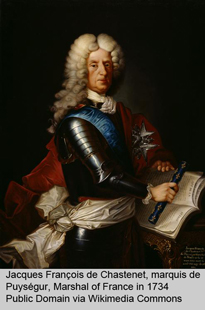Traité Des Armes des Machines de Guerre, des Feux ďArtifice, des Enseignes & des Instrumens Militaries Anciens & Modernes; avec la maniere dont on śen sert presentement dans les Armées, tant Francoises qúEtrangeres (Treatise on Weapons of War, Machines of Fireworks, & Teachings of the Ancient and Modern Military Instruments, with the manner in which they are used at this time in the Armies, both French and Foreign)

Little is known of Gaya, except that he was a Captain in the Champagne Regiment. He wrote:
While bayonets were sporadically issued to special troops, like fusiliers, dragoons, and grenadiers, the infantry remained dependent on pikemen. Many military engineers recognized that it would be far preferable to arm all soldiers with muskets and do away with the pike. However, there was considerable reluctance to do away with the pike. The debate over the pike continued for many years. The ratio of pikemen to musketeers slowly declined. However, into the last decade of the 17th Century, pikemen still continued to make up 20 to 25 percent of infantry formations.“The bayonet is about of the length of the dagger. It has no guard, but only a wood handle length of eight to nine inches. The blade is pointed & cutting, one foot long & a good inch wide. The bayonet is of great utility with the dragoons, the fusiliers & with the soldiers who are often ordered to go to war; because when they made their discharges, and have no ammunition, they put the handle in the muzzles of their fusils and defend as well as with a partisan.” [View an image of this passage and the bayonet illustration as it appears in his book.]
The bayonet evolved during the 1680s, taking on many of the the proportions and characteristics that it retains to the present day. The grip became shorter and its taper more pronounced. The metal crosspiece and pommel became the norm. A plug bayonet from my collection pictured below illustrates this evolution.

The plug bayonet’s rendering the musket inoperable was a major drawback. Once inserted into the muzzle, plug bayonets could be difficult to remove. Because early muskets were only effective at short range, the enemy could sometimes rush the musketeers as soon as they fired and be upon them before they could fix bayonets. Engineers sought ways to enable loading and firing the musket while the bayonet was mounted. One approach was the ring-bayonet, a plug bayonet with two rings through the hilt that encircled the musket barrel.
 Jacques François de Chastanet, Marquis de Puysegur (1656-1743), son of Jacques de Chastenet, Vicomte de Puységur, followed in his father's footsteps as a career soldier, rising to the coveted rank, Marshal of France. He authored a landmark work on military strategy: Art de la Guerre, Par Principes et par Régles. Ouvrage de M. le Maréchal de Puysegur (Art of War, Through Principles and Rules—Work by Mr. Marshal Puysegur). Published posthumously, in 1748, it describes soldiers equipped with ring bayonets prior to the Peace of Nijmegen, which was concluded in 1678:
Jacques François de Chastanet, Marquis de Puysegur (1656-1743), son of Jacques de Chastenet, Vicomte de Puységur, followed in his father's footsteps as a career soldier, rising to the coveted rank, Marshal of France. He authored a landmark work on military strategy: Art de la Guerre, Par Principes et par Régles. Ouvrage de M. le Maréchal de Puysegur (Art of War, Through Principles and Rules—Work by Mr. Marshal Puysegur). Published posthumously, in 1748, it describes soldiers equipped with ring bayonets prior to the Peace of Nijmegen, which was concluded in 1678:
"We might even configure the handle in a manner to put the end into the gun barrel, like the grenadiers’ bayonets before the use of socket bayonets. I will say that before the Peace of Nijmegen, I saw a regiment that wore swords which had that handle, and instead of the guard, had copper rings which passed over the muzzle of the gun and held it firm, the same effect as with our socket bayonets today." [View an image of this passage from Art of War.]
British General Hugh Mac Kay (c.1640–1692) also described use of the ring bayonet in writing of his experiences in the Scottish War of 1689:
"All our officers and souldiers were strangers to the Highlanders way of fighting and embattailling, which mainly occasioned the consternation many of them were in; which, to remedy for the ensuing year, having taken notice on this occasion that the Highlanders are of such a quick motion, that if a battalion keep up his fire till they be near to make sure of them, they are upon·it before our men can come to their second defence, which is the bayonet in the musle of the musket. I say, the General having observed this method of the ennemy, he invented the way to fasten the bayonet so to the musle without, by two rings, that the soldiers may safely keep their fire till they pour it into their breasts, and then have no other motion to make but to push as with a pick [pike]." [View an image of this passage from Mac Kay's book.]
In volume 2 of his 1801 work, Military Antiquities: Respecting a History from the Conquest to the Present Time, Francis Grose writes of a witness observing the ring bayonet in use during the reign of Queen Anne (1702–1714) and provides the following illustration of the ring bayonet the witness described. [View Grose's writings and illustration as it appears in his book.]

Muskets have also been observed with a tube brazed to the barrel, to accept the plug bayonet. Neither approach was very satisfactory. The ring bayonet fit loosely and was prone to dismount.
Next: 1690s—The Socket Bayonet
Back: 1670s—Official Military Adoption
Return to History of the Bayonet Index
© Ralph E. Cobb 2009 All Rights Reserved



